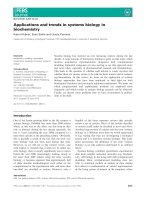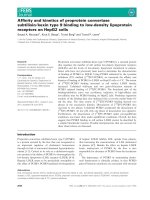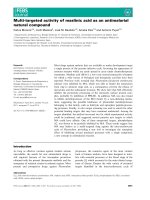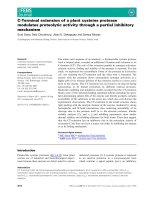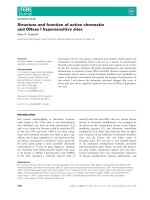Tài liệu Báo cáo khoa học: "WHERE QUESTIONS" pdf
Bạn đang xem bản rút gọn của tài liệu. Xem và tải ngay bản đầy đủ của tài liệu tại đây (264.32 KB, 4 trang )
WHERE qUESTIONS
Benny Shanon
The Hebrew University of Jerusalem
Consider question (i), and the answers to it, (2)-(h)~
(i) Where is the Empire State Building?
(2) In New York.
(3) In the U.S.A.
(h) On 3hth Street and 3rd Avenue.
When (i) is posed in California (2) is the appropriate
answer to it. This is the case even though (3) and (h)
are also true characterizations of the location of the
Empire State Building. The pattern of appropriateness
alters, however, when the locale where the question
presented changes. Thus, when (i) is asked in Israel,
(3) is the appropriate answer, whereas when it is asked
in Manhattan, (I~) is the answer that should be given.
The foregoing observations, originally made by Rumelhart
(197h) and by Norman (1973), suggest the following.
First, it is not enough for answers to questions to be
(semantically) true, they have to be (pragmatically)
appropriate as well. Second, appropriateness is not
solely determined by the content of the particular prop-
ositions in question, but also by the identity of the
participants in the particular conversational situation
and their locale. In other words, for a person or for
a machine, for that matter to answer questions, it is
not enough to survey one's memory and retrieve inform-
ation pertaining to the query posed, rather a selec-
tion algorithm has to be used so that an appropriate
response would be given. The specification of such a
selection algorithm is the topic of the present invest-
igation.
The following discussion is based on what is known as
the Room Theory: the original, albeit preliminary,
model proposed by Rumelhart(197~) in order to account
for his insightful observations. I try to examine the
psychological validity of this model, and to propose
amendments and extensions to it on the basis of empir-
ical data.
Theory. '[~le correspondence between the data and the
Theory is on two counts. First, there is the seeming-
ly trivial observation that answers tO different ques-
tions are given on diff,:rent levels. Specifically,
there is a correlation between the level of the object
which is queried and the room on which the respective
answer is given. Second, and less trivial, is the
observation that answers vary not only with the ques-
tions, but also with the spatial relationship which
holds between the object of the question and the parti-
cipants in the conversation. Several loci in the data
are indicative of this last pattern. First none of the
Americans indicated that the Empire State Building was
"in the U.S.", bu~ a third of the Israelis did so;
further, some of the Americans, but none of the Israelis,
indicated that the building was "in Manhattan". Second,
asked about New York City, almost all Israelis, but none
of the Americans, answered on the country level. Fur-
ther, the distribution of the answer patterns furnished
by the members of each group changed according to wheth-
er the queried city was their own, or close/distant
from it. Finally, children's answers to questions about
objects also vary with how distant the object is.
Above, however, I have qualified the correspondence bet-
ween the data and the theory; this qualification should
now be clarified. I don't think it is meaningful to
Judge the validity of a model llke the Room Theory by
examining the percentage of cases in which its predic-
tions hold. Such a percentage may reflect the structure
of the domain (questions) under investigation, and it
need not be indicative of the adequacy of the model as
such. The term "by and large" is, however, of qualit-
ative significance. It indicates that unless other
factors or reasons are operative, answers to where ques-
tions do, indeed, follow the Room A/gorithm. The detec-
tion of these "other factors and reasons", their class-
ification and the characterization of the answer types
that correspond to them is the main theme of this dis-
cussion. Following, then, are the answer patterns which
do not conform with the Room Theory.
The Room Theory "posits the existence of a psychologic-
al room relative to which distances are reckoned. The
room corresponds to the smallest geographical region
that encompasses both the reference location of the
conversants and the location of the places in question".
When answering where-questions "the rule is to find the
smallest room which Just includes the reference location
and the answer location. The appropriate answer is the
next smallest geographical unit which contains the loc-
ation in question, but axcludes the reference location".
(Rumelhart, 1975). The answers generated by this al-
gorithm, note, constitute the placing of the item ques-
tioned in a room which is larger than it; henceforth
answers of this type will be called vertical.
In order to examine the Room Theory, questions regard-
ing places in the world as well as objects in a (con-
crete) room were presented to several subject popula-
tions: college students in Israel and the U.S., Ameri-
can children of three age groups, and aphasic patients.
The present report concentrates on the adult data, and
only cursory remarks will be made on the answers furn-
ished by the other populations. First, I will discuss
answers solicited by an open questionnaire, in which
subjects were asked to give one answer to the questions
posel to them; later, answers solicited by closed ques-
tionnaires will be discussed.
First, it should be noted that by and large the answers
given by subjects were the ones predicted by the Room
First, consider questions about landm-~ks in the towns
in which the conversation took place. Most of the ans-
wers which involved vertical placement were given on the
level of the town itself, i.e. on a level which is high-
er than the one predicted by the Room Theory. The other
answers were not vertical, but rather horizontal:the
object questioned was related to another object similar
to it. In other words, either the level specified by
the Room Theory was changed, or the type of answer (i.e.
the generation algorithm itself) was altered. These
deviant answers are viewed as two 81ternative solutions
to the problem of the floor effect. Specifically, as
one goes down the place hierarchy, the specification of
rooms between the target and the least common room is
cumbersome; indeed, there might not be simple names by
which reference to these rooms may be made. Subjects
solve this problem either by staying on the level of the
least common room or by shifting to the horizontal
strate~,.
The same problem is noted with the ceilin~ effect, name-
ly, with
questions regarding objects which are very high
on the place hierarchy: continents for adults, countries
for children and aphasic patients. The answers in these
cases were varied, a feature which attests the algOr
ithm/c difficulty associated with them. Only a minor-
ity of the answers conformed with the Room Theory and
most answers were horizontal. Other answer types were:
vacuous, in which a vertical answer was given on too
high a level (e.g. "in the world"), featural, in which
73
a description, rather than a specification of the locale,
was given (e.g. "it is a continent"), or tautological
(e.g. "Japan is in Japan"). The di~'ferent answer types,
we shall say, are the products o~ different alternative
answer generation algorithms. The numerical distribu-
tion of these answers suggest that the order of prefer-
ence
for the application of the algorithms as the one
noted above.
There were also cases in which subjects gave answers on
a level lower than the one predicted by the Room Theory.
Thus, half the Israelis placed the Empire State Building
Tin New York", and not "in the U.S." Similarly, all the
Americans asked about the Eiffel Tower answered "in
Paris", and not "in France". These patterns are attrib-
uted to p romlnence. Prominent objects are ones which
gain a higher ra-~ in the place h/erarchy than would be
attributed to them on semantic classificatory grounds
alone. As a consequence, these objects are placed in a
room which is more specific then the one predicted by
the Room Theory. For instance, New York City is not
conceived of by non-Americans as Just another American
city; it gains an autonomy of its own and is conceived
of as independent of the country in which it is located.
The prominence effect suggests that rather than inter-
preting the room-hierarchy in a concrete fashion (i.e.
as isomorphic to the spatial relations which hold in
the physical world), one should view it as an abstract
conceptual representation. In this representation, ob-
Jects ere associated with ta~s: usually, objects which
are actually contained in objects of order n are assign-
ed a tag of order n÷l, but prominent objects are assign-
ed
tags of the same order as the objects which actually
contain them. Thus, if the Empire State Building is
tagged n÷l both New York and the U.S. are tngged n, for
the Israelis the least com-~n room (order n-l) is the
northern hemisphere, and the answer is given on the lev-
el of the t~o rooms of order n. Thus, the seemingly
unexpected answers associated with prominent objects are
due to the modified abstract representations, not to a
change in the(vertical) algorithm proper.
The salience effect is similar, but distinct. Objects
which are close to ones which stand ia a particular rel-
ation to the respondent (i.e. physically close, emotion-
ally dear, or belonging to the subject) are not placed
in a room but receive horizontal answers instead. For
example, all the Israelis answered that Lebanon was
"north of Israel", and not that it was "in the Mid-
East". Similarly, all the Americans (and half of the
Israells) placed Canada in relation to the U.S. Unlike
the prominence effect, the salience effect does affect
the answer generation algorithm itself, and it bears on
individual or cultural differences, not on general sem-
antic com-lderatlons. 4 Specifically, items which ere
special to the speaker are tagged in the representation
as marked, and this triggers a shift from the vertical
to the horizontal algorlthm.
All questions considered so far involved one config-
uration: the two conversants and the target were phys-
ically distinct, and together they could he contained in
one COmmOn room. This, however, is not the only possi-
ble con£iguratlon. Other confi&~aratious, are possible
as well: (a) The conversants and the target may coin-
cide in place, as in the question '~here are we now?".
(b) The conversants ~ay be contained in the target, as
in the question "Where is Israel?" when Posed in Jerus-
alem. (c) The conversants may be in different places,
as in phone conversations.
Strictly speaklng, the Room Algorithm does not apply to
these configuratlons. Thus, in (b) the least common
room is one level above that of the target, but on what
level would the answer be? The Room Algorithm would
either return the respondent to the place queried or
else require detailed and perhaps cumbersomDclassific-
atlons, neither option is taken. All the answers to the
questions noted were given on the room immediately above
the target. In (a) a least common room may not be cir-
cumscribed in the manner outlined by the Room Algorithm,
whereas in (c) a distinction between the speaker and the
hearer has to be introduced. All these cases suggest
that the different confi~Jrations do invoke different
generation algorithms. Hence, an appraisal of the con-
Flguration is necessary prior to the application of the
answer-generation algorithm proper.
So far, the discussion was topological, considering only
the spatial configuration holding between the conversants
and the object questioned. The respondent 's knowledge
of the world was not taken into account. In order to
prove the psychological validity of an answer generation
algorithm it is crucial to demonstrate that the answer
given is chosen from a class of several feasible answers,
and is not the only one possible due to a limited data
base. This was the purpose of the closed questionnaires.
Two such questionnaires were administered: first, sub-
Jests
were asked to choose the best of several answers
given to them; then they were asked to mark all the
answers they deemed true. Three points were of interest.
First, the answers given in the first two conditions
were not necessarily the most specified ones marked in
the third. Second, there were answers in the multiple
option condition which were evidently true and commonly
known but which were nonetheless not marked by subjects.
These answers included reversed prominence (i.e. the
relation of a prominent object to a less prominent one),
featural answers and ones which were too high on the
place hierarchy. Third, an "~ don't know" answer on
the open questionns/re did not necessarily imply a no-
answer in the other conditions. In other words, this
answer does not signify complete ignorance, but rather
an appreciation on the part of the subject that he can-
not f~u'nish the answer he deemm appropriate. Together,
the three points indicate that there is indeed a psy-
chological process of answer-generation which does not
amount to the specification Of the most detailed inform-
ation one has regarding the object in question.
Still another aspect which has to be considered is the
speaker's intention when he poses a question. A study
~ this aspect is just on its way now and at this point,
I have to limit myself only to a methodological discuss-
ion. Evidently, the process of question-answering re-
quires an appraisal of intention (of. Lehnert, !978),
one which involves the evaluation of various contertual,
personal and sociological factors. In order to make
research feasible, as well as constructive, a factor-
izatlon of the domain of question-answering, I believe,
is needed. In this regard the topological, knowledge
and intention aspects were noted. The original Room
Theory is an attempt to define the topological aspect.
The present study shows that even for this 8spect this
Theory is not sufficient. The present discussion sugg-
ests that an extended topological theory should consist
of the following components :
I. Semantic and episodic representations, which are
not isomorphic to the physically (logically)
defined room-hierar chy.
2. Determinants of confi~Irations and problematic
cases (floor, ceiling).
3. A
set of ordered answer-generation algorithms:
vertical place~nent (the algorithm proposed by the
Room Theory), horizontal relation, featural des-
crlption and non-informatlve (vacuous, tautolog-
Ical) •
Definitely, the topological consideration is not suffic-
ient for the characterization of how people answer where
questions. Future investigations should ex~cend the
research and also include considerations of k~owledge
and intention. At this Juncture, however, we can no~e
74
that it is not possible to reduce question answering to
knowledge alone, and that some formal selection algor-
ithms have to be postulated. The formal study of such
al~orithms is of relevance to the study of both natural
and artificial intelligence.
References
Lehnert, W.G. The process of question answering.
Lawrence Erlbaum and Associates, Hillsdale, N.J. •
1978.
Norman, D. Memory, knowledge and the answering of ques-
tions. In R. Solso (Ed.) Contemporar~ Issues in
Cognitive Psycholo~s', Washington, D.C. : E. Winston,
1973.
Rumelhart, D. The Room Theory. Unpublished manuscript,
The University of California at San Diego, 197h.
75


